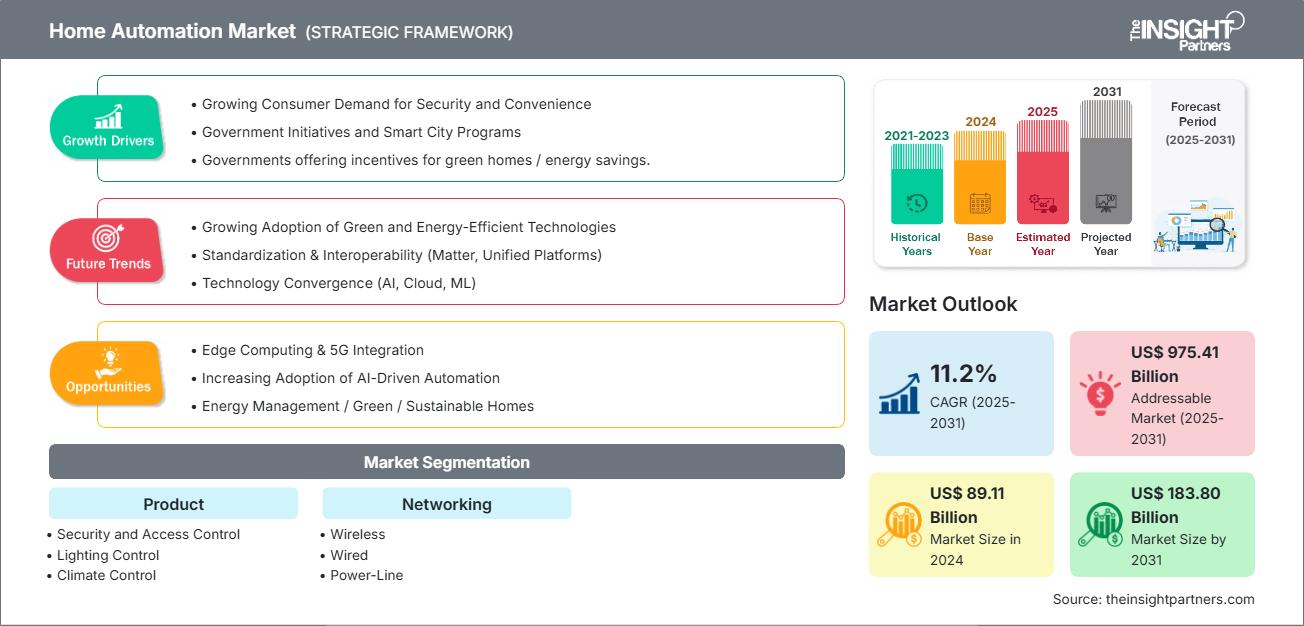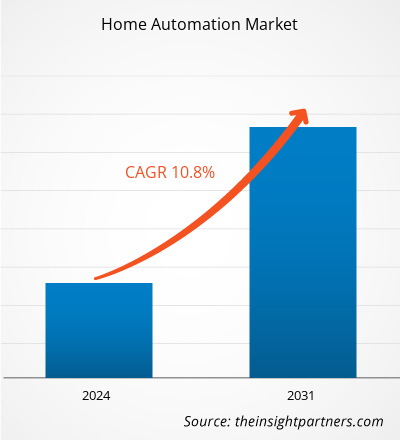홈 오토메이션 시장 규모는 2024년 891억 1천만 달러에서 2031년 1,838억 달러로 성장할 것으로 예상됩니다. 이 시장은 2025년부터 2031년까지 11.2%의 CAGR을 기록할 것으로 예상됩니다.
홈 오토메이션 시장 분석
글로벌 홈 오토메이션 시장은 편의성, 에너지 효율, 그리고 보안 기능을 원하는 소비자들의 주도로 상당한 성장을 보이고 있습니다. IoT, AI, 그리고 무선 통신 기술의 발전은 조명, 온도 조절, 엔터테인먼트, 그리고 홈 보안 시스템 등 다양한 시스템에 연결된 스마트 홈 기기를 통합했습니다. 소비자들이 스마트 홈의 이점에 대해 점점 더 인식하게 되면서, 스마트폰, 음성 비서, 그리고 쉽게 적응할 수 있는 시스템을 통해 소비자에게 접근하는 것이 가속화되고 있으며, 이는 스마트 홈 기술의 성장을 보여줍니다. 선진국들이 여전히 스마트 홈 도입을 주도하겠지만, 신흥 시장은 인터넷 사용 증가와 도시화로 격차를 빠르게 좁히고 있습니다. 시스템 통합, 지속 가능성, 그리고 개인화된 자동화 경험의 트렌드를 따라 시장은 계속해서 발전하고 있으며, 이는 미래 트렌드를 형성할 것입니다.
홈 오토메이션 시장 개요
글로벌 홈 오토메이션 시장은 조명, 난방, 환기, 에어컨, 가전제품, 보안 등 가정 내 시스템을 중앙에서 제어할 수 있는 기술을 포함합니다. 이 시장은 가정에서의 편의성, 에너지 효율, 그리고 안전성에 대한 수요 증가에 힘입어 성장하고 있습니다. 스마트폰, 음성 비서, 그리고 기타 스마트 기기와의 통합으로 이러한 시스템에 대한 접근성과 사용이 더욱 편리해졌습니다. 이 시장은 기존 주택의 리모델링과 신축 건물에 자동화 시스템을 추가하는 것을 모두 포함합니다. 소비자의 라이프스타일이 더욱 디지털화됨에 따라, 연결되고 사용하기 쉬운 가정 환경에 대한 수요는 지속적으로 증가하고 있습니다. 홈 오토메이션은 현대 생활에서 중요한 트렌드입니다.
이 보고서의 일부 또는 국가 수준 분석, Excel 데이터 팩을 포함하여 모든 보고서에 대한 사용자 정의를 무료로 받을 수 있으며, 스타트업 및 대학을 위한 훌륭한 혜택과 할인도 이용할 수 있습니다.
홈 오토메이션 시장: 전략적 통찰력

- 이 보고서의 주요 시장 동향을 알아보세요.이 무료 샘플에는 시장 동향부터 추정치 및 예측까지 다양한 데이터 분석이 포함됩니다.
홈 오토메이션 시장의 동인과 기회
시장 동인:
에너지 효율성에 대한 수요 증가:
소비자들은 비용과 환경 영향을 줄이기 위해 에너지 소비를 줄이는 데 점점 더 관심을 기울이고 있습니다. 홈 자동화 시스템은 조명, 난방, 냉방을 자동으로 제어하여 스마트한 에너지 관리를 가능하게 하여 도입을 촉진하고 있습니다.IoT와 스마트 기기의 급증하는 사용:
IoT 지원 기기의 확산으로 홈 시스템의 원활한 통합 및 원격 제어가 가능해졌습니다. 이러한 연결성은 사용자 경험과 편의성을 향상시켜 더 많은 주택 소유주가 자동화를 도입하도록 유도합니다.보안에 대한 우려 증가:
주택 소유주들은 안전과 보안을 중요하게 생각하며, 이로 인해 스마트 감시 카메라, 경보 시스템, 자동 잠금 장치에 대한 수요가 증가하고 있습니다. 이러한 시스템은 실시간 모니터링과 알림을 제공하여 안심할 수 있도록 도와줍니다.성장하는 반도체 산업:
자동화는 가전제품, 조명, 엔터테인먼트 시스템에 대한 중앙 집중식 제어를 가능하게 하여 일상 업무를 간소화합니다. 이러한 사용 편의성은 향상된 편의성과 시간 절약을 원하는 소비자에게 매력적입니다.
시장 기회:
재생 에너지 통합:
홈 오토메이션과 태양광 패널, 에너지 저장 시스템을 결합하면 지속 가능한 생활 솔루션을 위한 기회가 창출됩니다. 소비자는 재생 에너지 사용량을 모니터링하고 최적화하여 시스템의 매력을 높일 수 있습니다.저렴한 모듈형 솔루션:
확장 가능하고 비용 효율적인 스마트 홈 제품을 개발하면 더 많은 사람들이 자동화를 이용할 수 있습니다. 모듈식 시스템을 통해 사용자는 필요와 예산에 맞춰 맞춤 설정할 수 있어 시장 진출 범위가 확대됩니다.부동산 부문과의 협력:
기술 제공업체와 부동산 개발업체 간의 협업을 통해 신규 주택 프로젝트에 스마트 홈을 적용할 수 있습니다. 시공 단계부터 이러한 통합을 통해 광범위한 도입을 촉진할 수 있습니다.
홈 자동화 시장 보고서 세분화 분석
홈 오토메이션 시장은 작동 방식, 성장 잠재력, 그리고 최신 트렌드를 더욱 명확하게 보여주기 위해 여러 부문으로 구분됩니다. 대부분의 업계 보고서에서 사용되는 표준 세분화 방식은 다음과 같습니다.
제품별:
엔터테인먼트 센터:
홈 자동화 분야의 엔터테인먼트 센터는 원활하고 몰입감 있는 사용자 경험을 위해 오디오, 비디오, 미디어 시스템을 통합합니다.보안 및 접근 제어:
이 부문에는 스마트 잠금 장치, 알람, 비디오 도어벨, 감시 카메라, 생체 인식 접근 제어가 포함되어 있어 보안이 강화되고 원격 모니터링이 가능합니다.조명 제어:
조명 제어 시스템은 센서, 조광기, 일정 및 원격 제어를 사용하여 실내 및 실외 조명 관리를 자동화합니다.기후 제어:
기후 제어의 홈 자동화에는 편안함과 에너지 절감을 위해 난방, 냉방 및 공기 질을 최적화하는 스마트 온도 조절 장치, HVAC 제어 장치 및 환기 시스템이 포함됩니다.야외 자동화 시스템
: 야외 자동화는 잔디 스프링클러, 정원 조명, 수영장 시스템, 차고 문과 같은 외부 환경 요소를 중앙 제어를 통해 관리합니다.기타
: 이 세그먼트에는 스마트 가전(냉장고, 오븐), 블라인드/쉐이드, 에너지 관리 시스템, 센서, 음성 지원 장치 등 통합 스마트 홈을 완성하는 다양한 자동화 장치가 포함됩니다.
네트워크별:
열광한:
유선 네트워크는 물리적 케이블(일반적으로 이더넷, USB 또는 전력선 통신(PLC))을 사용하여 장치를 연결합니다.무선 전화:
무선 연결은 설치의 용이성, 유연성, 그리고 증가하는 기기 상호 운용성 덕분에 홈 자동화에 널리 사용됩니다.
지리별:
- 북아메리카
- 유럽
- 아시아 태평양
- 라틴 아메리카
- 중동 및 아프리카
북미 홈 오토메이션 시장은 가장 빠른 성장을 보일 것으로 예상됩니다. 이러한 성장세는 높은 소비자 인지도, 첨단 기술의 광범위한 도입, 탄탄한 인프라, 그리고 스마트 홈 혁신에 대한 막대한 투자와 지역 내 IoT 생태계 구축에 힘입은 것입니다.
홈 자동화 시장 지역별 통찰력
The Insight Partners의 분석가들은 예측 기간 동안 홈 오토메이션 시장에 영향을 미치는 지역별 동향과 요인을 면밀히 분석했습니다. 이 섹션에서는 북미, 유럽, 아시아 태평양, 중동 및 아프리카, 중남미 지역의 홈 오토메이션 시장 부문과 지역별 현황도 살펴봅니다.
홈 오토메이션 시장 보고서 범위
| 보고서 속성 | 세부 |
|---|---|
| 2024년 시장 규모 | 891억 1천만 달러 |
| 2031년까지 시장 규모 | 1,838억 달러 |
| 글로벌 CAGR(2025~2031년) | 11.2% |
| 역사적 데이터 | 2021-2023 |
| 예측 기간 | 2025-2031 |
| 다루는 세그먼트 | 제품별
|
| 포함된 지역 및 국가 | 북아메리카
|
| 시장 선도 기업 및 주요 회사 프로필 |
|
홈 오토메이션 시장 참여자 밀도: 비즈니스 역학에 미치는 영향 이해
홈 오토메이션 시장은 소비자 선호도 변화, 기술 발전, 그리고 제품 이점에 대한 인식 제고 등의 요인으로 인한 최종 사용자 수요 증가에 힘입어 빠르게 성장하고 있습니다. 수요가 증가함에 따라 기업들은 제품 라인업을 확장하고, 소비자 니즈를 충족하기 위한 혁신을 추진하며, 새로운 트렌드를 적극 활용하고 있으며, 이는 시장 성장을 더욱 가속화하고 있습니다.

- 홈 자동화 시장의 주요 기업 개요를 알아보세요
지역별 홈 자동화 시장 점유율 분석
아시아 태평양 지역은 향후 몇 년 동안 가장 빠른 성장세를 보일 것으로 예상됩니다. 라틴 아메리카, 중동, 아프리카의 신흥 시장 또한 홈 오토메이션 공급업체가 확장할 수 있는 많은 미개척 기회를 보유하고 있습니다.
홈 오토메이션 시장은 지역마다 성장세가 다릅니다. 아래는 지역별 시장 점유율과 동향을 요약한 것입니다.
1. 북미
시장 점유율:
글로벌 시장의 상당 부분을 차지합니다주요 동인:
- 소비자의 높은 인지도와 스마트 기술 도입 의지.
- 첨단 IoT 인프라와 광범위한 스마트폰 보급.
- 에너지 효율성과 보안 솔루션에 중점을 둡니다.
트렌드:
음성 인식 비서(Alexa, Google Assistant) 사용 증가.
2. 유럽
시장 점유율:
급속한 도시화의 상당 부분주요 동인:
- 엄격한 정부 규제는 에너지 효율성과 지속 가능성을 촉진합니다.
- 스마트 보안 및 감시 시스템에 대한 수요가 증가하고 있습니다.
- 가처분소득 증가와 디지털 리터러시 향상.
트렌드:
재생 에너지를 통합한 홈 자동화 도입이 증가하고 있습니다.
3. 아시아 태평양
시장 점유율:
매년 시장 점유율이 증가하는 가장 빠르게 성장하는 지역주요 동인:
- 급속한 도시화와 중산층 인구의 증가.
- 신흥 경제권에서 스마트폰과 인터넷 보급률이 증가하고 있습니다.
- 스마트 홈 기술을 통합한 부동산 개발이 증가하고 있습니다.
트렌드:
모바일 앱 기반 원격 제어 시스템에 대한 관심이 높아졌습니다.
4. 남미 및 중미
시장 점유율:
꾸준한 성장으로 성장하는 시장주요 동인:
- 전기 요금이 상승함에 따라 에너지 절약의 이점에 대한 인식이 높아지고 있습니다.
- 스마트 시티와 연결된 인프라 프로젝트에 대한 투자를 늘리세요.
- 스마트폰 사용자 기반 확대
트렌드:
가정 안전을 위한 스마트 보안 시스템의 점진적 도입.
5. 중동 및 아프리카
시장 점유율:
작지만 빠르게 성장하고 있습니다주요 동인:
- 스마트 홈 기능을 통합한 고급 부동산 시장이 성장하고 있습니다.
- 강화된 가정 보안 및 감시에 대한 수요가 증가하고 있습니다.
트렌드:
음성 및 모바일 기반 홈 자동화 제어를 사용합니다.
홈 오토메이션 시장 참여자 밀도: 비즈니스 역학에 미치는 영향 이해
높은 시장 밀도와 경쟁
존슨 컨트롤즈, 지멘스, 르그랑, 슈나이더 일렉트릭 등 기존 업체들의 존재로 경쟁이 치열합니다. 윙크 랩스, 피바로, 아보드 시스템즈, 컨트롤4와 같은 지역 및 틈새 시장 업체들 또한 여러 지역의 경쟁 구도를 더욱 심화시키고 있습니다.
이러한 높은 수준의 경쟁으로 인해 기업은 다음과 같은 서비스를 제공하여 두각을 나타내야 합니다.
- 스마트 조명 제어
- 기후 및 HVAC 자동화
- 홈 보안 및 감시
- 에너지 관리 시스템
기회와 전략적 움직임
- 기술 역량, 제품 포트폴리오 또는 시장 도달 범위를 빠르게 확장하기 위해 스타트업이나 전문 기업을 인수합니다.
- 통신 서비스 제공업체, 부동산 개발업체 또는 기술 회사와 협력하여 스마트 홈 솔루션을 더 광범위한 생태계에 통합합니다.
- 맞춤형의 저렴한 솔루션으로 신흥 시장에 진출하여 새로운 고객층을 확보합니다.
홈 오토메이션 시장에서 운영되는 주요 회사는 다음과 같습니다.
- 존슨컨트롤즈
- 지멘스
- 르그랑
- 슈나이더 일렉트릭
- 레지데오 테크놀로지스 주식회사
- 스냅 원, LLC
- 씨줄
- 크레스트론 일렉트로닉스 주식회사
- 레비톤 제조 주식회사
- 루트론전자(주)
면책 조항: 위에 나열된 회사는 특정 순서에 따라 순위가 매겨지지 않았습니다.
연구 중에 분석된 다른 회사:
- 체임벌린 그룹(MyQ)
- 레비톤 제조
- 아를로 테크놀로지스
- TP-Link(카사 스마트)
- 벨킨(WeMo)
- 이브 시스템즈
- 사반트 시스템즈
- 크레스트론 일렉트로닉스
- 루트론 일렉트로닉스
- ADT 주식회사
- 비빈트 스마트 홈
- 반지(아마존 소유)
- 어보드 시스템
- 윙크랩스
- 피바로
- 아카라
홈 오토메이션 시장 뉴스 및 최근 동향
Lutron Electronics Co., Inc.는 고품질 건축 조명 설비를 전문으로 하는 영국 최고의 제조업체인 Orluna LED Technologies Limited를 인수한다고 발표했습니다.
2025년 6월, 조명 제어, 자동 쉐이딩 솔루션, 지능형 조명기구 분야의 글로벌 리더인 루트론 일렉트로닉스(Lutron Electronics Co., Inc.)는 고품질 건축 조명기구를 전문으로 하는 영국 최고의 제조업체인 올루나 LED 테크놀로지스 리미티드(Orluna LED Technologies Limited)를 인수한다고 발표했습니다. 이번 인수는 루트론이 북미 이외 지역에서 처음으로 진행하는 인수입니다.스마트하고 건강하며 지속 가능한 빌딩 솔루션 분야의 글로벌 리더인 존슨 컨트롤즈는 오늘 OpenBlue 디지털 생태계의 일부인 디지털 솔루션인 OpenBlue Enterprise Manager 제품군에서 AI 기능을 크게 확장했다고 발표했습니다.
2024년 11월, 스마트하고 건강하며 지속 가능한 빌딩 솔루션 분야의 글로벌 리더인 존슨 컨트롤(Johnson Control)은 OpenBlue 디지털 생태계의 일부인 OpenBlue Enterprise Manager 디지털 솔루션 제품군의 AI 기능을 대폭 확장했다고 발표했습니다. 이번 업데이트에는 최초의 고객 대상 생성형 AI 애플리케이션, 더욱 자율적인 빌딩 제어, 그리고 대폭 향상된 사용자 경험이 포함됩니다. 이러한 업데이트를 통해 2025년까지 전 세계적으로 인정된 성능 기준, 비용 절감을 위한 최적화된 장비 성능, 그리고 강화된 규정 준수에 중점을 둔 추가적인 AI 기능 향상을 위한 토대를 마련했습니다.
홈 자동화 시장 보고서 범위 및 제공물
"홈 자동화 시장 규모 및 예측(2021~2031)" 보고서는 아래 영역을 포괄하여 시장에 대한 자세한 분석을 제공합니다.
- 범위에 포함된 모든 주요 시장 부문에 대한 글로벌, 지역 및 국가 수준의 홈 자동화 시장 규모 및 예측
- 홈 자동화 시장 동향 및 드라이버, 제약 및 주요 기회와 같은 시장 역학
- 자세한 PEST 및 SWOT 분석
- 주요 시장 동향, 글로벌 및 지역 프레임워크, 주요 참여자, 규정 및 최근 시장 개발을 포괄하는 홈 자동화 시장 분석
- 홈 자동화 시장의 시장 집중도, 히트맵 분석, 주요 업체 및 최근 개발 사항을 다루는 산업 환경 및 경쟁 분석
- 자세한 회사 프로필
- 과거 분석(2년), 기준 연도, CAGR을 포함한 예측(7년)
- PEST 및 SWOT 분석
- 시장 규모 가치/거래량 - 글로벌, 지역, 국가
- 산업 및 경쟁 환경
- Excel 데이터세트
최근 보고서
사용 후기
구매 이유
- 정보에 기반한 의사 결정
- 시장 역학 이해
- 경쟁 분석
- 고객 인사이트
- 시장 예측
- 위험 완화
- 전략 기획
- 투자 타당성 분석
- 신흥 시장 파악
- 마케팅 전략 강화
- 운영 효율성 향상
- 규제 동향에 발맞춰 대응




















 무료 샘플 받기 - 홈 오토메이션 시장
무료 샘플 받기 - 홈 오토메이션 시장